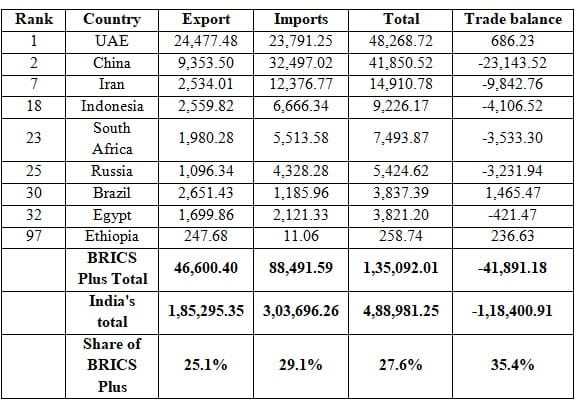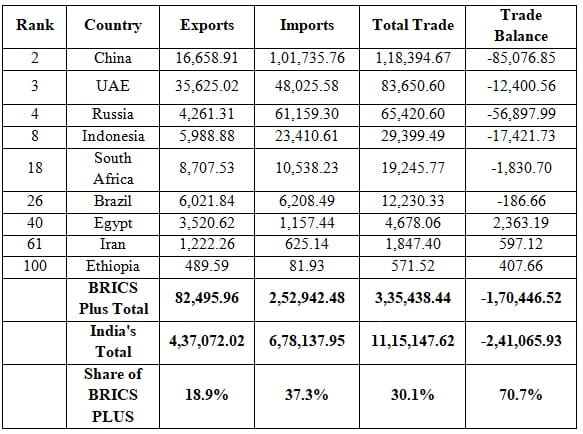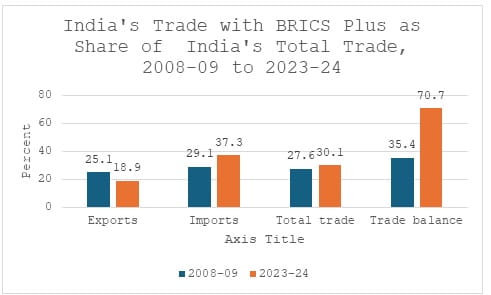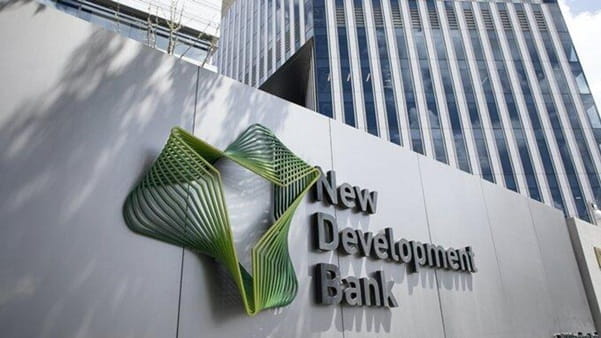
BRICS Plus/Outreach-format meeting, Kazan, Russia, 22-24 October 2024. | BRICS 2024 Russia
For India, as a large and rapidly growing major economy, it would be important that the efficacy of BRICS initiatives remains high. It should work towards hosting the BRICS secretariat and taking a leadership role in the grouping as it expands.
Introduction
In 2009, following the disruptive global economic crisis led by developed economies the previous year, Brazil, China, India and Russia agreed to come together on a common platform to further the interests of emerging economies and expand their cooperation. With the inclusion of South Africa in 2010, the forum gained the acronym BRICS. At the 16th summit meeting in Kazan under Russia’s presidency in October 2024, four more countries - Egypt, Ethiopia, Iran and the UAE - joined the forum, while Indonesia was included as a full member by Brazil on 1 January 2025. Nine other countries were added as partner countries as well from this date, leading to a comprehensive expansion of the grouping.
Since its inception, BRICS, now referred to as BRICS Plus, has marked notable milestones in cooperation, exemplified by the establishment of the New Development Bank (NDB) as an alternative multinational development bank. The BRICS Pay and BRICS Bridge as fintech cooperation mechanisms are concrete outcomes as well. BRICS Bridge or the BRICS Cross Border Payment Initiative which aims to provide an alternative international payments system was mooted at the Kazan summit. A BRICS Institute of Future Networks Study Group on AI, Startup Forum and others have also been initiated in recent years.
The Kazan summit declaration placed high priority on cooperation across a range of economic issues, including ICT, e-commerce, special economic zones, food security and agriculture and MSMEs, among others. The progress in the Partnership for a New Industrial Revolution (PartNIR) through various events and training programs was noted and it was decided to set up seven working groups to promote growth and innovation covering sectors such as chemicals, SMEs, among others. The launch of a BRICS Centre for Industrial Competencies was also mentioned in the declaration. The document stressed financial sector cooperation through BRICS Clear, a cross-border settlement and depository infrastructure, as well as BRICS (Re) Insurance Company and other reinsurance initiatives, with voluntary participation. Alternative currencies, strengthening of the BRICS Contingency Reserve Arrangement and financial sector cyber resilience were discussed as well.
While a multi-dimensional cooperation framework has been created and new areas of engagement have been added, the development status of the economies of the grouping has changed over the years. Russia was classified as a ‘high-income country’ for the first time in 2023, as per the World Bank development categories. China graduated from a ‘lower middle-income country’ to an ‘upper middle-income country’ in 2010. India shifted from a ‘low-income country’ to a ‘lower middle-income country’ in 2007 and since then, its per capita income has risen from $1,023 to an estimated $2,698, greatly enhancing its market size and outward engagement. Among the new entrants, the UAE’s per capita income levels are rather high at around $48,000, while Indonesia stands at around $5,000.
Trade and investment
As BRICS was established with a view to strengthen economic cooperation among the members, it is pertinent for India to explore the benefits that its membership in the forum has yielded for its economy over the years. Most of the current member countries (BRICS Plus), including the new ones, are – or earlier – were India’s major trade partners, except Ethiopia. India’s total goods trade with these countries stood at about $335 billion in 2023-24, up from $189 billion in 2008-09. China, the UAE and Russia figured among the top five trade partners of India in terms of total trade in 2023-24. Indonesia came in at 8th and South Africa ranked 18th.
India’s total exports to its nine trading partners in BRICS Plus stood at over $82 billion dollars in 2023-24, accounting for 19 per cent of its total exports. On the other hand, BRICS Plus countries are a major source of imports for India, with the aggregate standing at $253 billion dollars, which is 37 per cent of its total imports. This attests to the immense role that these countries play in India’s economy.
While India’s exports to the original BRICS partners expanded by 75 per cent over the 15 years from 2008-09 to 2023-24, its imports went up by almost 188 per cent. The spike in imports is primarily due to oil imports - of which imports from Russia ballooned owing to geopolitical reasons - and imports from China. India thus has a huge trade deficit in the grouping. The BRICS Plus countries accounted for as much as 71 per cent of India’s total trade deficit of $241 billion in 2023-24. Within this, China alone accounts for over 35 per cent.
India’s Trade with BRICS Plus 2008-2009, $ million

Source: Ministry of Commerce and Industry; Author’s calculations
India’s Trade with BRICS Plus 2023-24, $ million

Source: Ministry of Commerce and Industry; Author’s calculations
As seen in the chart below, India’s export share to BRICS Plus countries has declined over the period 2008-09 to 2023-24, while the share of its total imports from the group rose. This has adversely affected its trade balance, which doubled over the period as a share of India’s total trade deficit.

Source: Ministry of Commerce and Industry; Author’s calculations
There are several inferences from the above trade data. First, India has not been able to adequately tap the BRICS markets, despite the fact that imports by all these countries have increased substantially in the last ten years. There is a need to undertake a dedicated initiative to boost exports, as the original BRICS nations are the largest developing economies.
Second, looking at the products exported from India, these remain concentrated in a few items and have not diversified as per India’s manufacturing capabilities. A mapping exercise must be undertaken to identify the best products for exports to these countries at a granular level and to implement steps to expand these.
Third, India’s imports from these countries have helped drive its growth; however, the trade imbalance has been a concern. Various tariff and non-tariff barriers as well as ease of doing business would have to be identified and taken up with the partner nations to encourage greater Indian exports.
On the investment side, the UAE as the new entrant to BRICS Plus is the largest investor from the grouping in India. The country has emerged as one of India’s most proactive economic partners and has prioritised its trade and investment with India through a free trade agreement. Total investment from the UAE as per the official data stands at $19 billion, while the rerouted investments via other countries could be even higher.
The UAE is also a preferred destination for India’s overseas direct investment (ODI) and Indian companies have invested $16 billion in the country. India has also invested in Russia to the tune of close to $13 billion, primarily in oil fields and other resources. FDI inflows from China stood at $200 million over the last four years. India’s cumulative investments in China are less than $1 billion.
It appears that India’s membership of BRICS, and now BRICS Plus, has delivered below expectations in terms of trade and investments, especially since India is the second-largest economy in the grouping.
President Trump and BRICS
With President Donald Trump unfurling a revisionist trade regime after assuming charge in the United States, the BRICS grouping faces exigent uncertainties. The new president has specifically targeted the grouping on several occasions, particularly on its goal towards alternative currencies and trade in local currencies, which is viewed as an attempt for de-dollarisation by the BRICS members. On 30 January 2025, he threatened to impose 100 per cent tariffs against BRICS members if they moved towards replacing the US dollar in trade. On 13 February, he emphasized that BRICS was ‘dead’ and that if the countries ‘play games with the dollar’ they would be hit with the stated tariff. This was reiterated on 21 February.
In the first meeting of the BRICS Sherpas under the presidency of Brazil, President Lula of Brazil on 26 February responded by emphasising the grouping’s commitment to multilateralism and said that alternative platforms for payments between member countries would continue to be promoted. The tariff war unleashed by President Trump subsequently has led to various retaliatory actions, including by China which stated that the country has never succumbed to bullying and coercion.
This reflects a tendency among BRICS countries to stand their ground when it comes to unilateral tariff impositions by the US. While BRICS has so far not taken a common position on the tariffs or on President Trump’s threats in the case of de-dollarisation attempts, individual members are likely to work on a response of bilateral negotiations with the US and quietly going slow on plans towards alternative payment mechanisms within BRICS, while not formally suspending them. This could work in India’s favour, given that the BRICS alternative payment systems are being established by China and any alternative currency is likely to boost the use of the renminbi which is already being strongly pushed by China. India could, however, encourage more countries to use its United Payment Interface (UPI).
In an evolving situation, it may be premature for President Trump to say that BRICS is ‘dead’. At the same time, some countries contemplating joining BRICS may likely re-consider their strategy.
Conclusion
The expansion of the BRICS forum with five new members, nine new partner countries and several more countries in the waiting room reflects the benefits that countries of the Global South perceive in joining the group. However, discussions on tariff, non-tariff issues, standards and codes, and other matters which could encourage trade between the members are not part of the remit. India can leverage BRICS Plus as a platform for promoting trade and investment within the grouping and introducing a greater focus on trade in goods and services through discussions on resilient supply chains, trade facilitation, digitalisation of trade, and standards and norms. At the same time, it must be careful that these standards are not imposed by other countries and are aligned with its own domestic capabilities.

The New Development Bank. | Sputnik India
The New Development Bank, where India is the second-largest shareholder, represents a major achievement for BRICS, and has been ramping up its project financing. It has approved 96 projects with financing of $32.8 billion, mainly in the sustainability sectors. The loans are primarily sovereign loans but in general, these projects add to private sector opportunities. The NDB aims to mobilise more private funds and should also diversify from sovereign lending to give more projects to the private sector.
The use of digital currencies can begin with the countries that have already instituted the system in place or will shortly do so. Distributed ledger technology and interoperability will help in payments and settlements. A strong focus on data security would need to be maintained to protect against cyber crimes and inadmissible use of data. The decisions on BRICS Bridge, BRICS Clear, BRICS Pay, among others, are yet to be implemented so their architecture is not clear and they will take some time to take off, particularly with President Trump’s tariff threats looming large.
A key gap in the overall architecture of BRICS Plus is the absence of a running secretariat. As with the G20 grouping, the current BRICS presidency assumes administrative responsibility and this is passed on from one presidency to the next. This gives the current presidency a high degree of flexibility in developing the agenda; on the other hand, it also acts counter to uninterrupted flow of work and consistency in activities.
A BRICS secretariat would support continued initiatives of the grouping and could work in a dedicated manner on promoting economic and financial cooperation among the countries, rather than depend upon infrequent meetings of various working groups and sectoral platforms set up on different issues. This gains greater relevance in an evolving geopolitical context where events are rapidly transforming the environment for developing countries to grow.
For India, as a large and rapidly growing major economy, it would be important that the efficacy of BRICS initiatives remains high. It should work towards hosting the BRICS secretariat and taking a leadership role in the grouping as it expands.
(Exclusive to NatStrat)